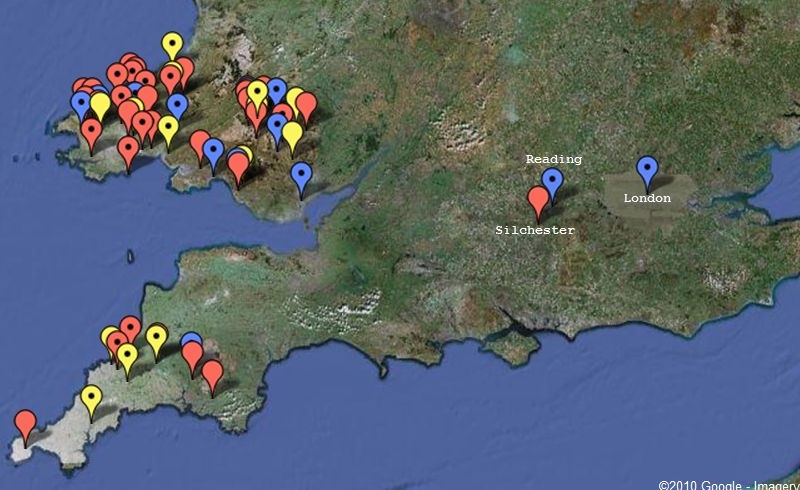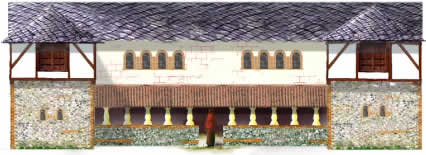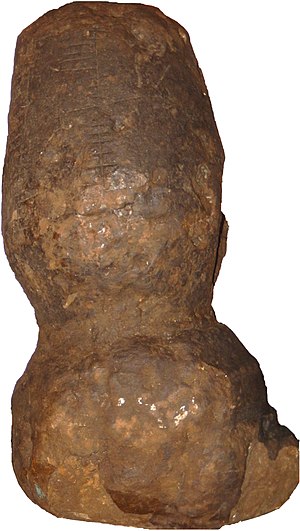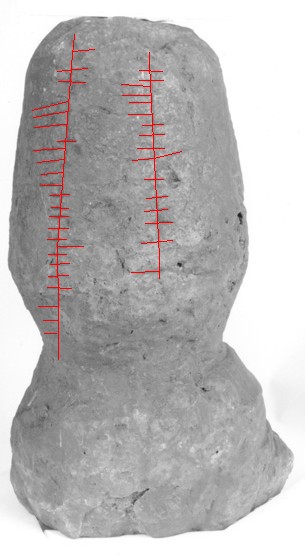BabelStone Blog
Thursday, 12 November 2009
The Ogham Stones of Elsewhere
- The Ogham Stones of Cornwall and Devon
- The Ogham Stones of Wales
- The Ogham Stones of Scotland
- The Ogham Stones of the Isle of Man
- The Ogham Stones of Ireland
- The Ogham Stones of Elsewhere
Ogham stones occur throughout the areas of Britain that border the Irish Sea, from Shetland and Orkney in the north, through Scotland, the Isle of Man and Wales, down to Devon and Cornwall in the south. Perhaps suprisingly, there are no known Ogham stones from the area of Northern England between Wales and Scotland that up until the early medieval period was inhabited by a Brythonic-speaking people, or from Brittany, which was a destination for Irish missionaries such as Saint Colombanus. Less surprising is the fact that Ogham stones do not occur in those areas that are beyond the immediate sphere of Irish influence, and that are far from the well-travelled sea routes from Ireland to the west coast of Britain. Thus, outside of Cornwall and the far west of Devon, England is, with a single exception, devoid of any Ogham stones. This single exception is to date the only known certain example of an Ogham stone inscription from elsewhere than Ireland, Scotland, the Isle of Man, Wales or Dumnonia.
The Silchester Ogham Stone
This unique Ogham stone was found in 1893 during the excavation of Silchester Roman Town in Hampshire, about 95 miles from the nearest other Ogham stone at Crickhowell in Powys.
Location of the Silchester Ogham Stone
Red tags mark Ogham stones (Clusters of Ogham Stones to the west in South Wales and Cornwall)
The Ogham inscription is carved on a dwarf column made of sandstone, about 60cm in height, that was placed upsidedown at the bottom of a well by the west end of the southern corridor of House 1, Insula IX. Re-excavation of the site in 1998-2000 unearthed some fragments of oak at the bottom of the well, which have been radiocarbon-dated to 130-380 and 320-540, giving a probable date for the closing of the well of about 350-425. Archaeologists working on the Silchester site believe that the depositing of the Ogham-inscribed stone in the well marked both the sealing of the well, and the end of occupation of the associated building. They further suggest that the stone was used as a mark of ownership of the associated late Roman dwelling by an Irish immigrant named Tebicatos, perhaps standing proudly in front of the front door, as shown in this reconstruction :
The House of Tebicatos
Reconstruction of the House of Tebicatos by Margaret Mathews
The vast majority of Irish Ogham inscriptions are carved along the vertical edges of a stone (using the edge as a natural stemline), but this example is unusual in that the inscription is written along two artificial stemlines running vertically up the face of the stone. Together with the fact that this Ogham stone is so distant from any other Ogham stone, this uncommon (but certainly not unkown) manner of carving the Ogham text has caused some to throw doubt on the authenticity of the inscription. But in the absence of any evidence that the Victorian gentlemen carrying out the 1893 excavation were cunning hoaxers, it seems unlikely to me that the inscription is not genuine; and the recent excavations appear to confirm this opinion (see M. Fulford, M. Handley and A. Clarke, "An early date for Ogham: the Silchester Ogham Stone rehabilitated" in Medieval Archaeology 44 (2000) : 1-23). The simple explanation would seem to be that Tebicatos came to inhabit an old Roman dwelling during the late Roman or early sub-Roman period, and that he or his comemmorators simply used a pre-existing Roman dwarf column to carve their message on, and as the column did not have any angular edges, the inscription had of necessity to be written on the face along artificial stemlines — I do not see anything suspicious about this scenario. As mentioned above, one possibility for why the inscription was made was that it marked ownership of the building, and that the inscription was carved onto the dwarf column in situ, whilst still a functioning architectural feature of the house. However, it seems unlikely to me that in a Roman town, with presumably very few other Irish inhabitants, Tebicatos would publicly mark ownership of his house in a script and language that almost none of the town's other inhabitants could read. Welsh and Dumnonian Ogham stones are almost exclusively memorial stones (often with an accompanying hic iacit inscription in Latin), and thus I think that the Silchester Ogham stone would have been set up as a memorial to Tebicatos on his death, perhaps utilising a column from an abandonned or derelict building. It is much more plausible that a memorial stone would use a script and language that Romans and Romanized Britons could not read, as memorial stones are more ritualistic in function than utilitarian — it would not matter if the Romans and Britons could not understand the inscription, just so long as the spirit of Tebicatos could.
The Silchester Ogham Stone
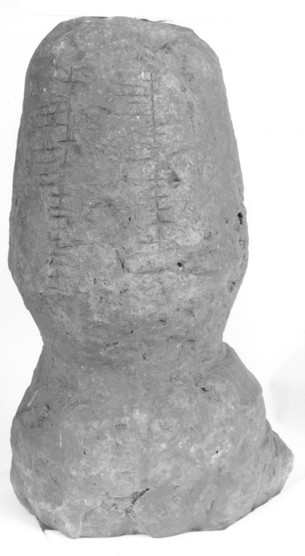
Click on image of stone to show an overlay of the inscription
The Ogham inscription is linguistically quite typical of Irish Ogham stone inscriptions, being written in standard Primitive Irish, and reading TEBICATOS MAQI MUCOI [...] "Of Tebicatos, son of the tribe of ..." (or "Of Tebicatos, son of the descendant of ..."). Unfortunately the name of his ancestral tribe has been lost at the top of the righthand stem. However, the name Tebicatos appears to be British (Brythonic) rather than Irish (Goidelic). Although the initial element Teb- is of uncertain meaning, it is paralleled in the name of Tibatto, leader of the Bacaudae in Farther Gaul, who led a rebellion in 435-437; and it may also be related to the medial element in the names Vortipor and Votiporigis. The final element -catos means 'battle" (Old Irish cath, Old Welsh cat), and is attested in names such as Ambicatos 'having battle around himself', son of Rocatos (ANDRS/1), and Ambigatos, king of the Bituriges in central Gaul. Perhaps Tebicatos was an Irish immigrant who adopted a British name (or Brythonifed his original name) or perhaps he was the member of an Irish family who was born in Silchester and so had a British name.
The Uttoxeter Ogham Stone
After having first published this post, it came to my attention that there is one more purported English Ogham stone, discovered by a Victorian antiquarian and amateur archaeologist, Francis Redfern, in 1870 at Uttoxeter in Staffordshire, about 65 miles from the nearest Welsh Ogham stone at Clocaenog in Denbighshire. The Ogham inscription is said to have been carved on a piece of Roman millstone made from volcanic rock from Andernach in Germany, found in the mud surrounding a well near to a possible Roman fort and Roman road. The stone is now lost, and as Redfern does not seem to have published a drawing of the stone or its inscription, it is difficult to make a judgement about the authenticity of the inscription. However, it does have interesting parallels with the Silchester stone — both inscriptions are carved on stone objects leftover from Roman usage rather than on natural stones, and both stones were found in or by wells in Roman settlements. If the Silchester stone is an outlier of the Irish Kingdom of Brycheiniog in south-east Wales, then the Uttoxeter stone can be seen as an outlier from the even closer north Welsh Kingdom of Gwynedd.
Hampshire
 Silchester Stone (SILCH/1)
Silchester Stone (SILCH/1)
| Site | Silchester Roman Town, Hampshire. |
| NGR | SU 6838 6255 |
| Current Location | Reading Museum [1995.1.24]. Not on display; stored in the off-site storage facility. |
| History | Discovered in 1893, upsidedown at the bottom of a well by the west end of the southern corridor of House 1, Insula IX. |
| Description | Roman dwarf column made of greensand, with two parallel vertical Ogham inscriptions on one side. |
| Dimensions | 0.60 × 0.36 × 0.36 m. |
| Date | 350–425 (Fulford et al. 2000) |
| Notes | Viewed 25 July 2016 in Reading Museum storage facility. The inscription is carved along artificial stemlines on the surface of the stone because the column does not have any sharp edges. |
| References |
CISP SILCH/1 NMR Monument No. 241215 Macalister 1945 #473 Fulford et al. 2000 |
|
Photo by BabelStone, 25 July 2016, CC BY-SA 3.0 |
|
Photo © M. Fulford |
Ogham Inscription
| Ogham Text | ᚈᚓᚁᚔᚉᚐᚈᚑᚄ (left stemline, bottom-to-top) |
| ᚋᚐᚊᚔᚋᚒᚉᚑᚔ (right stemline, bottom-to-top) | |
| Transcription | TEBICATO[B!] | [--][H!]IMUCO[--] |
| Reading | TEBICATO[S] [MAQ]I MUCO[I] [--] |
| Translation | Of Tebicatos, son of the tribe of ... |
| Notes | The reading of Tebicatos is based on Handley 1999; Macalister 1945 reads the name as Ebicatos. |
Staffordshire
 Uttoxeter Stone (UTTOX/1)
Uttoxeter Stone (UTTOX/1)
| Site | Maiden's Well, Uttoxeter, Staffordshire. |
| NGR | SK 0949 3264 |
| Current Location | Lost. |
| History | Discovered in 1870 by Francis Redfern, in the mud by a well. |
| Description | Fragment of a millstone made from volcanic stone (tuff) from Andernach. |
| Dimensions | Unknown. |
| Date | |
| Notes |
"The fosse way [Icknield Street] which I have traced over the High Wood passed by the remain; and Maiden's Well, although most likely of Celtic date, would be resorted to by the cohort of the camp. From the mud about this well I have recovered a piece of a Runic stone of a tuberous and dark character, with ogham characters on it." (Redfern 1873 page 270). "In 1870 I found what proves to be an interesting relic in the vicinity of Maiden's Wall Well, on Uttoxeter High Wood. Before attempting to introduce any notice of the object in these pages, I submitted it to the inspection of three gentlemen for for their opinion upon it. Mr. Fradgley, architect, and the late Mr. Lucas, of Bentley Hall, deemed it to be of great antiquity, and the Rev. Mr. Kerry, of Puttenham, has not hesitated to declare it to be a portion of a Runic stone bearing Ogham characters. The stone itself is a piece of sonorous and dark tuff, probably from Andernach on the Rhine. Ogham letters are merely straight strokes arranged in groups along a line, as in the instance on this fragment, and mostly contain the name of the person in whose honour such stones were erected." (Redfern 1886 page 47). |
| References |
NMR Monument No. 305133 Redfern 1873 Redfern 1886 |
References
- CISP : Celtic Inscribed Stones Project. Department of History and the Institute of Archaeology, University College London.
- NMR : National Monuments Records. English Heritage.
- Fulford et al. 2000 : M. Fulford, M. Handley and A. Clarke, "An early date for Ogham: the Silchester Ogham Stone rehabilitated" in Medieval Archaeology 44 (2000) : 1-23
- Macalister 1945 : R. A. S. Macalister, Corpus Inscriptionum Insularum Celticarum Vol. I. Dublin: Stationery Office, 1945.
- Redfern 1873 : Francis Redfern, "On Uttoxeter and the Archæological Remains of the Parish and Neighbourhood"; in Journal of the British Archaeological Association vol.29 (1873) pages 263–278.
- Redfern 1886 : Francis Redfern, History and Antiquities of the Town and Neighbourhood of Uttoxeter (2nd ed.). London, 1886.
Key
The following conventions are used in the transcription of Latin, Runic and Ogham inscriptions :
- [X] = letter X assumed but it is unclear or uncertain
- [X^Y] = letter is uncertain but may be either X or Y
- [X!] = Ogham letter is incomplete, and may be X or any letter from the same series as X with more strokes than X (e.g. [T!] is equivalent to [T^C^Q], and [A!] is equivalemt to [A^O^U^E^I])
- [-] = single missing or obliterated letter
- [--] = unknown number of missing or obliterated letters
- {X} = unusual glyph form of letter X (description on mouseover)
- {XY} = ligatured form of letters X and Y
- (X) = letter X in the inscription is extraneous and should be omitted in the reading
- <X> = letter X is missing in the insciption and should be added in the reading
| Letter | Name | Transcription | Notes |
|---|---|---|---|
| ᚁ | Beith | B | |
| ᚂ | Luis | L | |
| ᚃ | Fearn | F | Read as F or V. |
| ᚄ | Sail | S | |
| ᚅ | Nion | N | |
| ᚆ | Uath | H | |
| ᚇ | Dair | D | Variants include 'Rabbit-eared D'. |
| ᚈ | Tinne | T | |
| ᚉ | Coll | C | |
| ᚊ | Ceirt | Q | |
| ᚋ | Muin | M | |
| ᚌ | Gort | G | |
| ᚍ | nGéadal | W | Read as Ng or Gw. |
| ᚎ | Straif | Z | Read as Z or St. |
| ᚏ | Ruis | R | Double R is occasionally written as a crosshatched ligature. |
| ᚐ | Ailm | A | Variants include 'Hammerhead A' and 'S-shaped A'. |
| ᚑ | Onn | O | |
| ᚒ | Úr | U | |
| ᚓ | Eadhadh | E | |
| ᚔ | Iodhadh | I | |
| ᚕ | Eabhadh | X | Read as É or K. |
| ᚖ | Ór | Ó | |
| ᚗ | Uilleann | Ú | |
| ᚘ | Ifin | P | Written as a single cross under the stemline in epigraphic texts. |
| ᚙ | Eamhancholl | Not found in epigraphic texts. |
Ogham Fonts
This page is best viewed if the set of 12 BabelStone Ogham fonts are installed on your system.
Revised: 2017-07-25
Index of BabelStone Blog Posts
